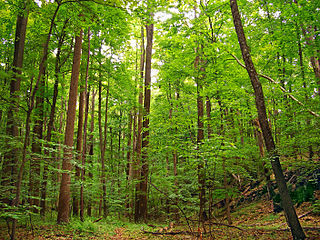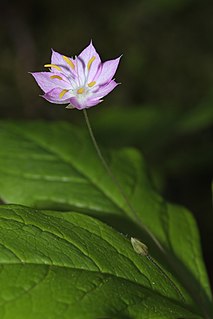
Prasophyllum petilum, commonly known as the Tarengo leek orchid, is a species of orchid endemic to eastern Australia. It has a single tubular, green leaf and up to eighteen pinkish mauve to greenish flowers, well-spaced along a slender flowering stem. It is a small orchid, difficult to locate, generally growing in taller grasses.
Prasophyllum campestre, commonly known as the sandplain leek orchid, or inland leek orchid, is a species of orchid endemic to eastern Australia. It has a single tubular, yellowish-green leaf and up to twenty greenish, strongly scented flowers with red, purplish, brown or white marks. It grows in the drier parts of Queensland, New South Wales and Victoria.
Prasophyllum apoxychilum, commonly known as the tapered leek orchid, is a species of orchid endemic to Tasmania. It has a single tubular, green leaf with a purplish base and up to twenty light green and whitish flowers. It is very similar to P. truncatum, and there is some doubt as to whether the two species are distinct. The species is known from twenty widely separated populations and is usually only seen in disturbed sites, such as after fire.

Prasophyllum canaliculatum, commonly known as the channelled leek orchid or summer leek orchid, is a species of orchid endemic to a small area of southern New South Wales. It has a single tubular, bright green leaf and up to twenty five scented, greenish-red or brownish flowers on a flowering stem. It grows in woodland at altitudes around 1,000 m (3,000 ft) where only about two hundred plants survive.

Prasophyllum caricetum, commonly known as the Cathcart leek orchid, is a species of orchid endemic to a small area of southern New South Wales. It has a single tubular, bright green leaf and up to twenty five green, white and purplish flowers crowded on the flowering stem. It grows in montane swamps near Cathcart.
Prasophyllum castaneum, commonly known as the chestnut leek orchid, is a species of orchid endemic to Tasmania. It has a single tubular, dark green leaf with a dark purplish base and between ten and twenty chestnut coloured to dark brown flowers. In 2000, the entire population was estimated to be about fifty plants.
Prasophyllum favonium, commonly known as the western leek orchid, is a species of orchid endemic to Tasmania. It has a single tubular leaf with a reddish base and between five and fifteen brownish flowers with a dark purple labellum. In 2000, the entire population was estimated to be less than forty mature plants in a very small area.
Prasophyllum incurvum is a species of orchid endemic to Tasmania. It has a single tubular, bright green leaf and up to forty brownish-green, white and purplish flowers. It is similar to P. alpestre but has larger flowers and petals which curve forwards.
Prasophyllum keltonii, commonly known as Kelton's leek orchid, is a species of orchid endemic to a small region of New South Wales. It has a single tubular, bright green leaf and up to twenty two scented, green, brownish-red or purplish flowers. It is a very rare orchid with only a few hundred plants known.
Prasophyllum limnetes, commonly known as the marsh leek orchid, is a species of orchid endemic to Tasmania. It has a single tubular, green leaf and up to thirty five greenish-white flowers with a pinkish labellum. It is only known from a population of fewer than twenty plants growing in a sanctuary near Port Sorell.
Prasophyllum milfordense is a species of orchid endemic to Tasmania. It has a single tubular, dark green leaf and up to thirty greenish-brown, white and purplish flowers. It is a very rare orchid, only found in a single location with a population of around 240 plants.
Prasophyllum olidum, commonly known as the pungent leek orchid is a species of orchid endemic to Tasmania. It has a single tubular, green to yellowish-green leaf and up to thirty bright green to brownish-green flowers. It is a very rare orchid, only found in a single location with a population which fluctuates from three to two hundred flowering plants.
Prasophyllum pulchellum, commonly known as the pretty leek orchid, is a species of orchid endemic to Tasmania. It has a single tubular, green leaf and up to twelve light reddish-brown flowers with a cream-coloured to whitish labellum. It is widely distributed in Tasmania and only about 130 plants are known but it is difficult to locate in the low heath where it grows and more individuals may survive.
Prasophyllum spicatum, commonly known as the dense leek orchid, is a species of orchid endemic to southern mainland Australia. It has a single tubular, green leaf and up to fifty brownish and white or greenish and white flowers crowded in a cylinder-shaped spike.
Prasophyllum stellatum, commonly known as the Ben Lomond leek orchid, is a species of orchid endemic to Tasmania. It has a single tubular, dark green leaf and up to twenty greenish-brown to brownish flowers with a white labellum. It is only known from two disjunct populations, at Ben Lomond and near Deloraine.
Prasophyllum taphanyx, commonly known as the graveside leek orchid, is a species of orchid endemic to a small area of Tasmania. It has a single tubular, green leaf and up to twenty five small, light green, pinkish-cream and purplish flowers. It rarely flowers and the largest number of flowers seen in any one year was three in 2001.

Prasophyllum tunbridgense, commonly known as the Tunbridge leek orchid, is a species of orchid endemic to Tasmania. It has a single tubular, bright green leaf and up to twenty five relatively large, green to light greenish-brown flowers with white petals and a large white labellum.
Prasophyllum atratum, commonly known as the Three Humock leek orchid, is a species of orchid endemic to Tasmania. It has a single tubular, dark green leaf and up to twenty five brownish- to purplish-green flowers with a dark purplish labellum. It is only known from a single population of fewer than one thousand plants growing on Three Hummock Island.

Prasophyllum basalticum is a species of orchid endemic to New South Wales. It has a single tubular, dark green leaf and up to fifteen scented, greenish-brown to brownish-red flowers with a white and green labellum. It grows in grassy woodland on the Northern Tablelands.
Prasophyllum holzingeri is a species of orchid endemic to New South Wales. It has a single tubular, shiny dark green leaf and up to fifteen unscented, greenish to brownish pink and white flowers. It is only known from a few populations in the Barrington Tops area.















